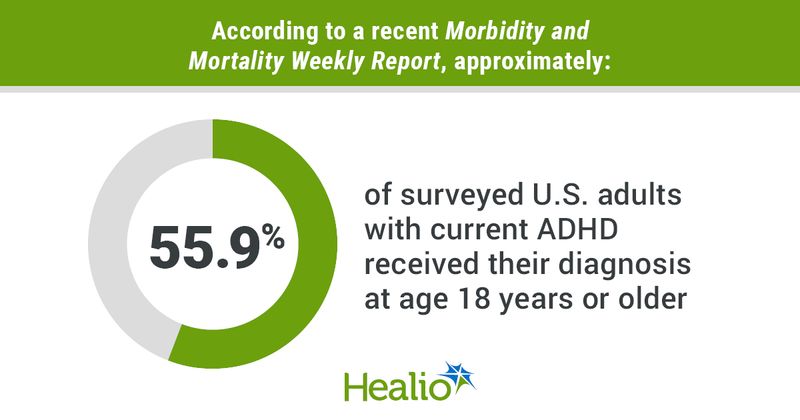One in 16 US adults estimated to have ADHD, with more than half diagnosed in adulthood
Key takeaways:
- An estimated 6% of U.S. adults have ADHD.
- Medication shortages affected 71.5% of those taking a stimulant medication for ADHD.
- Almost half of these adults reported ever using ADHD telehealth services.
Researchers estimated that 6%, or one in 16, U.S. adults had an ADHD diagnosis, more than half of whom were diagnosed in adulthood, according to findings published in the CDC’s Morbidity and Mortality Weekly Report.
Such information on the prevalence and treatment of ADHD in U.S. adults is needed to help develop clinical care guidelines and regulatory decision-making, according to the researchers.

“No national data exist on ADHD treatment in U.S. adults, and national prevalence estimates of current ADHD in adults rely on data from 2003,” Brooke S. Staley, PhD, of the CDC’s National Center on Birth Defects and Developmental Disabilities and Epidemic Intelligence Service, and colleagues wrote in the report.
“Timely data are needed to develop clinical guidelines and guide decision-making for policies, including regulation concerning stimulant prescription and telehealth access for ADHD in U.S. adults,” they added.
To estimate the prevalence of ADHD diagnosis and treatment among U.S. adults, Staley and colleagues analyzed National Center for Health Statistics Rapid Surveys System data from 7,046 interviews of U.S. adults that were completed in October 2023 and November 2023. Of them, 444 (55.8% men; 70.4% white) had a current ADHD diagnosis, 55.9% of whom received their diagnosis at age 18 years or older.
Based on those data, the researchers estimated that 15.5 million U.S. adults — or one in 16 — had a current ADHD diagnosis in 2023.
The results further showed that 35.2% of adults with ADHD were receiving both medication and counseling or behavioral treatment during the survey period, whereas 36.5% were not receiving any treatment at all.
During the 12 months prior to the survey period, 50.4% of adults with ADHD were prescribed medication to treat their condition; of them, 33.4% reported taking prescription stimulant ADHD medication and 5.9% reported taking nonstimulant ADHD medication.
Among those who reported taking stimulant ADHD medication, 71.5% had difficulty getting their prescription filled due to the medication being unavailable.
Overall, 46% of surveyed adults with ADHD reported ever receiving ADHD-related telehealth services; of them, 8.9% received their diagnosis via telehealth only and 9.5% received their diagnosis via both in-person and telehealth visits.
Staley and colleagues acknowledged several study limitations, including the use of self-reported health data, which may be subject to recall and reporting biases.
“Public health professionals can use the findings from this report to better understand the prevalence of ADHD in adulthood, how adults obtain ADHD care, the potential gaps or delays in diagnosis and the magnitude of treatment needs,” they wrote. “As policies are currently developed and evaluated related to ADHD clinical care for adults, access to prescription stimulant medications and flexibilities related to telehealth, these results can guide clinical care and regulatory decision-making.”

